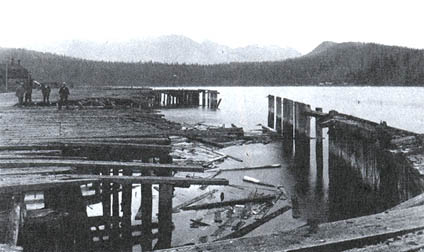Vol. 17 No. 1
January, 1987
|
Keep the Ball Rolling
Stay Safe in 87
|

Port Moody's Status
as Pacific Terminal
Short-Lived
|

Dave Jones
Corporate
Archives
|
While the Canadian Pacific Railway was being pushed through the
mountains and around the North Shore of Lake Superior in 1884, there was a great deal of speculation as to
which West Coast community would be the road's Pacific terminal, and reap the inevitable economic benefits
of that position.
The two original contenders were Victoria, on Vancouver Island, and Port Moody at the eastern tip of Burrard
Inlet.
Although Port Moody had been specified by the federal government in the railway's charter, as it was the
nearest navigable waterway, there were some drawbacks to the site.
Apart from being 22 kilometres from the entrance of the first narrows at English Bay, a steep hill ran up
from the waterside leaving little room for townsite development. Also, the tide varied by as much as 4.2
metres and the port was subject to fog.
In the spring of 1884, Van Horne made the trip to the coast to assess the situation. Together with Premier
William Smith of Victoria and Member of Parliament A.W. Ross of Winnipeg, he registered at the Elgin House,
an established local hostelry, and received a number of prominent citizens who defended the suitability of
Port Moody as the western terminus of the CPR.
Not wishing to show his hand too early, Van Horne was very non-committal, although he did state
outright that no extensions or branchlines would be made from Port Moody without a considerable land grant
from the federal government to cover the cost of construction.
Certainly, the company's own over-extended resources did not leave any possibility of the CPR
financing such a line, and this was confirmed upon his return to Montreal after a meeting of the board of
directors.
Equally, Van Horne made it quite clear that Port Moody could not remain as the terminus indefinitely.
"The matter has been carefully considered by our directors," he reported, "and they have
concluded that there is not sufficient available room at Port Moody for their requirements, as it is
estimated that not less than 400 acres of level ground will be required for railway purposes alone, and it
would cost from two to four million dollars to reclaim this amount of land from the tide flats at Port
Moody."
RIVALS TARGET OF PORT MOODY SCORN
The citizens of Port Moody however, determined to defend their interest in the matter, continued to promote
their townsite as the terminus, while heaping scorn upon all potential rivals.
Due to the enormous cost of ferrying the trains to Victoria, should that location have been chosen, Vancouver
Island never really received serious consideration. By this time, the principal rivals to Port Moody were
Coal Harbour and English Bay, both sites having adequate depth of water and plenty of adjacent flat land.
Initially, however, Port Moody would have to suffice, and dock facilities and storage sheds were erected in
preparation for the opening of the railway line. In keeping with the plans to soon extend the line, the wharf
piles were constructed of wood rather than iron, and the station and storage facilities were modest.
Despite the inevitable move, Port Moody was determined to make the most of the occasion when the first
scheduled passenger train arrived there on 4 Jun 1886.
A letter sent to Van Horne read in part: "We heartily congratulate you, and the other members of
the Directory of the Canadian Pacific Railway, on this the arrival of the first through daily train, at Port
Moody, the western terminus of the Canadian Pacific line."
Within days, the first chartered ship, the W.B. Flint, arrived from the Orient with a cargo of 17,430
half-chests of tea headed for the east. Seven chartered vessels were sent from Japan during the
next six months, and passenger trains left on a daily-except-Monday basis.
Alas, Port Moody's heady days as the busy Pacific port of the CPR did not last long, and the following year
the line officially was extended to the new townsite of Vancouver on Coal Harbour.
The port facilities were disassembled and the docks abandoned, leaving the town to its destiny as a
residential suburb of the western terminus and bustling metropolis of Vancouver.

Photographed around 1900, the general condition of the
wharves at Port Moody showed their abandonment. The CPR station is in the background,
left.
This CP Rail News article is copyright
1987 by the Canadian Pacific Railway and is reprinted here with
their permission. All photographs, logos, and trademarks are the property of the Canadian Pacific Railway
Company.
|
|